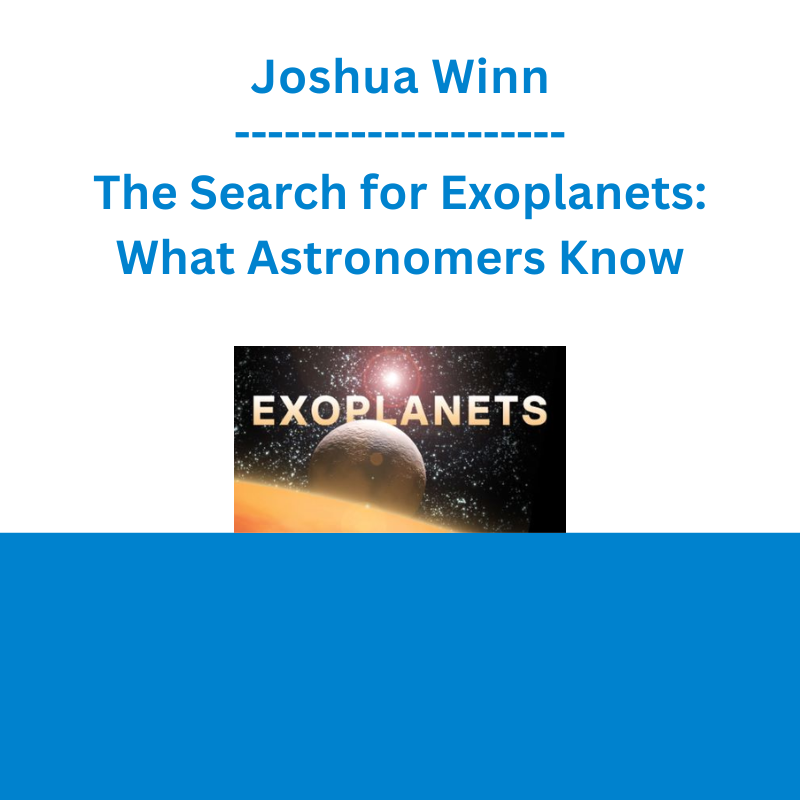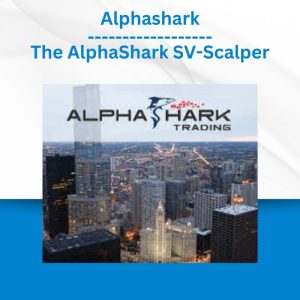*** Proof of Product ***
Exploring the Essential Features of “Joshua Winn – The Search for Exoplanets: What Astronomers Know”
The Search for Exoplanets: What Astronomers Know
There’s no place like home … unless we can find another home in a galaxy far, far away. Let’s see how that is working out for us.
LECTURE
Trailer
01:Why Study Exoplanets?
Learn about the exciting mission of exoplanetary science-the study of planets orbiting stars beyond the Sun. Review the eight planets in our solar system, which provide a baseline for understanding the more than 1,000 worlds recently discovered in our region of the Milky Way galaxy….
31 min
02:How to Find an Exoplanet
Given the extreme faintness of a planet relative to the star it orbits, how can astronomers possibly find it? Learn about direct and indirect methods of detection. As an example of the indirect method, discover why a planet causes a star’s position to change, providing a strategy for locating exoplanets without seeing them….
30 min
03:Doppler and Transit Planet-Finding Methods
Explore two other indirect approaches for finding exoplanets: first, by measuring the Doppler shift in the color of a star due to the pull of an unseen orbiting planet; and second, by measuring the tiny drop in the brightness of a star as a planet transits in front of it….
32 min
04:Pioneers of Planet Searching
Chart the history of exoplanet hunting-from a famous false signal in the 1960s, through ambiguous discoveries in the 1980s, to the big breakthrough in the 1990s, when dozens of exoplanets turned up. Astronomers were stunned to find planets unlike anything in the solar system….
31 min
05:The Misplaced Giant Planets
Investigate 51 Pegasi b, the first planet detected around a Sun-like star, which shocked astronomers by being roughly the size of Jupiter but in an orbit much closer to its star than Mercury is to the Sun. Probe the strange characteristics of these “hot Jupiters,” which have turned up around many stars….
30 min
06:Explaining the Misplaced Giant Planets
The standard theory of planet formation is based on our solar system. But does this view require revision based on the existence of misplaced giant planets-hot Jupiters circling close to their parent stars? Compare competing theories that try to resolve this conflict….
31 min
07:The Transits of Exoplanets
A tiny percentage of exoplanets can be detected transiting-or passing in front of-their host stars. Combined with Doppler shifts, transits provide information about a planet’s size, mass, density, and likely composition. Learn how ambitious amateur astronomers can use this detection technique in their own backyards….
32 min
08:Sniffing Planetary Atmospheres
Survey the history of spectroscopy to understand how a telescope and a diffraction grating can disclose the composition of a star and its planet. Then learn how transits and occultations are ideal for analyzing planetary atmospheres, paving the way for the search for signatures of life….
31 min
09:Stellar Rotation and Planetary Revolution
Trace Professor Winn’s own search for the subtle signs that tell whether a star has a tilted axis. Discover why this is an important clue in the mystery of misplaced giant planets. Also hear how he chanced into the field of exoplanetary science….
30 min
10:Super-Earths or Mini-Neptunes?
Learn how a sensitive new instrument led the way in finding planets smaller than the Jupiter-sized giants that dominated the earliest exoplanetary discoveries. Halfway in size between Earth and Neptune, these worlds have uncertain properties. For clues about their nature, consider how our solar system formed….
31 min
11:Transiting Planets and the Kepler Mission
The planet search took a giant leap forward in 2009 with the launch of the Kepler spacecraft, which used the transit technique to observe nearly 200,000 stars over a four-year period. Study Kepler’s goals, results, and the persistence of the astronomer who championed it….
31 min
12:Compact Multiplanet Systems
Dig deeper into the treasure trove of data from the Kepler mission, which discovered hundreds of compact multiplanet systems, with planets much more closely packed than in our solar system. Explore the dynamics of these groupings, which have planets interacting strongly through mutual gravitation….
31 min
13:Planets Circling Two Stars
See how data from the Kepler spacecraft confirms a scenario straight out of the movie Star Wars: a planet with two suns. Investigate the tricky orbital mechanics of these systems. A double star also complicates the heating and cooling cycle on a planet. However, the view is spectacular!…
31 min
14:Lava Worlds
Explore the theoretical limit of the smallest possible orbit for a planet, taking into consideration tidal stresses and other destructive processes. Then focus on Professor Winn’s search for such objects, which found probable lava worlds-planets heated to rock-melting temperatures by their extreme closeness to their host stars….
31 min
15:Earthlike Planets
Begin your search for planets that may harbor life by studying the conditions that make Earth habitable, including its distance from the Sun, surface temperature, atmosphere, and oceans. Then examine strategies for finding earthlike planets and the progress to date….
31 min
16:Living with a Dwarf Star
The most common stars are class M dwarf stars, which are smaller and less luminous than the Sun (class G). Earth-sized planets are much easier to detect around M-dwarf stars, especially if the planets are within the relatively close-in habitable zone. Explore examples and the prospect for life on such worlds….
31 min
17:Living with a Giant Star
In billions of years, the Sun will expand into a red giant, possibly engulfing Earth. Learn how planet-finding techniques give astronomers insight into the processes inside giant stars. Then study the planets around these behemoths for clues about Earth’s ultimate fate….
31 min
18:Our Nearest Exoplanetary Neighbors
Pinpoint the location of the nearest exoplanetary systems to Earth. First, get the big picture on the layout of our Milky Way galaxy, its size, and the Sun’s position. Also learn why the Kepler spacecraft focused on exoplanets much more distant than those targeted by the Doppler technique….
30 min
19:Finding Planets with Gravitational Lensing
Get a lesson in Einstein’s general theory of relativity to understand an effect called gravitational microlensing, which allows astronomers to deduce a planet’s existence without recording any light from the planet or its host star. This technique reveals exoplanets that would otherwise go undetected….
31 min
20:Finding Planets with Direct Imaging
Turn to the most obvious way to find exoplanets: direct imaging. Explore the optics of telescopes to learn why spotting an exoplanet next to its parent star is so difficult. Then see how this limitation has been overcome in a handful of cases….
30 min
21:Near-Term Future Planet-Finding Projects
The success of exoplanetary science has spurred a wave of new projects to increase our knowledge of worlds beyond our solar system. Survey ground- and space-based programs that are now in the works. Professor Winn gives a preview of a space mission that he and his MIT colleagues are designing….
28 min
22:Long-Term Future Planet-Finding Projects
Peer into the future at ambitious projects that may one day succeed in collecting light directly from an Earth-sized planet in the habitable zone of a nearby star. Examine three different engineering approaches: the coronagraph, interferometer, and starshade….
30 min
23:The Search for Life on Exoplanets
Join the quest for life on exoplanets, focusing on the search for extraterrestrial intelligence (SETI)-a hunt for signals from alien civilizations inspired by a landmark paper in 1959. See how the famous Drake equation points to factors that determine how many such civilizations may exist….
31 min
24:Coming Soon: Biosignatures, Moons, and More!
Explore the distinctive biosignatures that show the presence of life of any kind on an exoplanet. Then close with Professor Winn’s tip sheet on exoplanetary discoveries likely in the near future-from evidence of moons to planets being destroyed by giant stars….
31 min
DETAILS
Overview
Join the search for another Earth in this 24-lecture series that explores the brand-new science of exoplanets-worlds that exist outside of our solar system.
About
Joshua N. Winn
There are so many reasons to study exoplanets, including exploration, the search for life, the rich physics problem of planet formation, and the technological challenge.
Dr. Joshua N. Winn is the Professor of Astrophysical Sciences at Princeton University. After earning his Ph.D. in Physics from MIT, he held fellowships from the National Science Foundation and NASA at the Harvard-Smithsonian Center for Astrophysics. Dr. Winn’s research goals are to explore the properties of planets around other stars, understand how planets form and evolve, and make progress on the age-old question of whether there are other planets capable of supporting life. He was a member of the science team of NASA’s Kepler mission and is the Deputy Science Director of a future NASA mission called the Transiting Exoplanet Survey Satellite. He has authored or coauthored more than 100 scientific articles on the subject of exoplanetary science. At MIT, Dr. Winn teaches physics and astronomy and has won several awards for his dedication to his students, including the Buechner Faculty Teaching Prize in 2008 and the School of Science Prize for Excellence in Graduate Teaching in 2013. His talent for communicating science to the general public was honed during graduate school, when he wrote for the science section of The Economist.
REVIEWS
Moonseeds
Decent content, boring delivery
I slogged through this course and it wasn’t until lecture 18 that I figured out that if I watched on my iPad and mirrored it to my AppleTV (preferred way to watch) that I could increase the playback speed. Currently, the app for AppleTV does not offer this option. This instructor would be excellent at ASMR.
Otherwise it’s an interesting topic that was well covered, likely for someone with very little background information which is understandable. At lecture 20, he finally got to stuff I hadn’t heard before elsewhere and gave insight to upcoming missions. It sure was tough sticking with it until then and I did fall asleep during several of the lectures.
George51
Highly recommended!
I have just finished watching Prof Winn’s lectures on searching for exoplanets. Prof Winn’s diction is clear, his pace of delivery is neither too fast, nor too slow, and the visuals provide great help in comprehending the lectures’ contents. The professor explained the various equations in a way that made them accessible also to a non-expert audience. The course is highly recommended to all those who are interested in Astronomy.
Gwick
Great teacher, Great class
An excellent course by Prof. Joshua Winn. This is my second with him and this time he focuses on his own research on Exoplanets. Astronomy discovery is moving quickly now, and although set in approx. 2014, this still sets a needed basis for understanding Exoplanet research (It would be great if he could update it for 2023). Wondrium has a series of excellent Astronomy & Astrophysics classes, which have greatly enriched my amateur astronomy work. They take time, some math & note taking helps, but short of enrolling in a University program it has been satisfying, helpful and fun to do. Please add more. Thanks
Please see the full list of alternative group-buy courses available here: https://lunacourse.com/shop/










 Melissa Ingold - Workbook - How to Plan Your Funnels + Trip Wires Like a Boss
Melissa Ingold - Workbook - How to Plan Your Funnels + Trip Wires Like a Boss  Jane Roberts - The Seth MP3 #33 - Digital Download - Seth Center
Jane Roberts - The Seth MP3 #33 - Digital Download - Seth Center  Julie Stoian & Cathy Olson - Launch Gorgeous - Funnel Gorgeous Bundle
Julie Stoian & Cathy Olson - Launch Gorgeous - Funnel Gorgeous Bundle